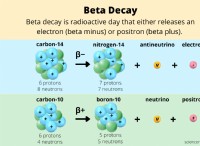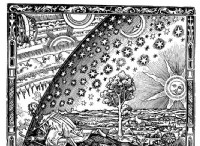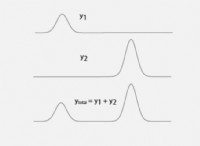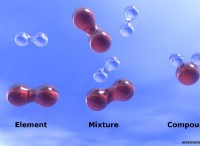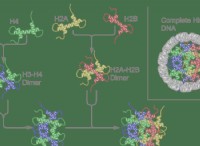場の量子論は、これまでで最も成功した科学理論である可能性があり、驚異的な精度で実験結果を予測し、高次元数学の研究を進めています。それでも、何かが欠けていると信じる理由もあります。スティーブン・ストロガッツは、ケンブリッジ大学の理論物理学者であるデビッド・トンと話し、この謎めいた理論の未解決の問題を探ります.
Apple Podcasts、Spotify、Google Podcasts、Stitcher、TuneIn、またはお気に入りのポッドキャスト アプリで聴くか、Quanta からストリーミングできます .
トランスクリプト
スティーブン・ストロガッツ (00:03):私はスティーブ・ストロガッツです。これはThe Joy of Whyです 、Quanta Magazine のポッドキャスト これにより、今日の数学と科学における最大の未解決の問題のいくつかにたどり着きます。
(00:12) 私たちが実際に何でできているのか疑問に思ったことがあるなら、おそらく発見のうさぎの穴に落ちていることに気付いたでしょう.もちろん、他の生物と同じように、私たちも細胞でできています。そして、細胞は分子でできており、分子は原子でできています。さらに深く掘り下げると、すぐに電子とクォークのレベルに到達します。これらは、従来、物質の基本的な構成要素である終点であると考えられてきた粒子です。
(00:39) しかし、今日では、そうではないことがわかっています。代わりに、物理学者は、最も深いレベルでは、すべてが神秘的な実体、つまり量子場と呼ばれる流体のような物質で構成されていると言っています.これらの目に見えないフィールドは、粒子のように振る舞うこともあれば、波のように振る舞うこともあります。それらは互いに相互作用することができます。それらのいくつかは、私たちの中を流れることさえあります。量子場の理論は、間違いなく史上最も成功した科学理論です。場合によっては、驚異的な小数点以下 12 桁まで実験と一致する予測を行います。その上、場の量子論は、特に 4 次元形状やさらに高次元の空間の研究において、純粋数学の特定の問題に大きな光を当ててきました。しかし、場の量子論には何かが欠けていると信じる理由もあります。数学的に不完全なようで、多くの未解決の問題が残されています.
(01:38) このすべてについて話し合うために、私と一緒に参加してくれるのは David Tong 教授です。 David はケンブリッジ大学の理論物理学者です。彼の専門は場の量子論であり、非常に才能のある教師および解説者としても有名です。彼の多くの栄誉の中で、彼は 2008 年にケンブリッジ大学が授与する最も権威のある賞の 1 つであるアダムス賞を受賞しました。彼はまた、シモンズ財団から科学者や数学者に与えられる賞であるシモンズ研究員でもあり、基本的な問題を研究しています。シモンズ財団もこのポッドキャストに資金を提供しています。デビッド、今日はご参加いただきありがとうございます。
デビッド トン (02:15):こんにちは、スティーブ。よろしくお願いします。
ストロガッツ :お話しする機会があり、とてもうれしく思います。インターネットであなたの講義を読んだり、YouTube で素晴らしい講演をいくつか見たりして楽しんでいます。だから、これは素晴らしい御馳走です。基本から始めましょう。今日はフィールドについて話します。誰がそれらを作成したか教えてください。通常、Michael Faraday が功績を認められます。彼の考えは何でしたか?そして、彼は何を発見しましたか?
トン (02:37):すべてはマイケル・ファラデーにまでさかのぼります。ファラデーは、史上最高の実験物理学者の 1 人であり、理論家ではなく実験物理学者でした。彼は 14 歳で学校を中退しました。彼は本質的に数学を知りませんでした。そしてさらに驚くべきことに、彼は宇宙の仕組みについてこの直感を築き上げました。それは、彼が理論物理学に最も重要な貢献をしたことを意味します。約 25 年間、彼は電気と磁気のアイデアで遊んでいました。彼は磁石を手に入れ、銅線を巻きつけていました。彼は、電磁誘導の発見や電気モーターの発明など、かなり重要なことをいくつか行いました。
(03:19) そして約 20 年後、彼は非常に大胆な提案を行いました。物事がどのように機能しているかを説明するために頭の中で作り上げた図は、実際には私たちが住んでいる宇宙の正しい説明であるということです.
(03:33) では、例を挙げましょう。 2 つの棒磁石を一緒に押して、2 つの N 極が互いに近づくようにすると、これは私たち全員が行った実験です。そして、これらの磁石を一緒に押すと、それらを押し離すスポンジ状の力を感じます.ファラデーは、磁石の間に実際に何かがあるという非常に大胆な提案をしました。驚くべきことに、そこにある磁石を見ると、そこには何もないことがわかります。しかし、ファラデーはそこに何かがあると言いました。そこには現在磁場と呼ばれるものがあり、彼はそれを力線と呼びました。そして、この磁場は磁石自体と同じくらいリアルでした.
(04:11) つまり、私たちが住んでいる宇宙についての非常に新しい考え方でした. 彼は、宇宙には粒子があるだけでなく、さらに別の種類のオブジェクト、非常に異なる種類のオブジェクトがあることを示唆しました. 、空間のどこにでも一度に存在するフィールド。彼は、現代の言葉で言えば、宇宙のあらゆる点に 2 つのベクトル、2 つの矢印があると言いました。これらのベクトルは、電場と磁場の方向と大きさを教えてくれます。
(04:43) それで、彼はこの宇宙の写真を私たちに残しました。そこには、2 つの非常に非常に異なるオブジェクトがあるという一種の二分法があります。電場と磁場を設定している粒子があります。そして、これらの電場と磁場自体が波打って進化し、粒子にどのように動くかを伝えています.したがって、粒子が行っていることとフィールドが行っていることの間には、この種の複雑なダンスがあります。そして本当に、彼の大きな貢献は、これらのフィールドが現実であり、粒子と同じくらい現実的であるということでした.
ストロガッツ (05:12):それでは、量子力学が発見された後、場の概念はどのように変化したのでしょうか?
トン (05:18):量子力学が登場する頃には、現在は 1925 年です。そして、私たちはこの種の独特な世界観を持っています。したがって、電場と磁場があることがわかります。そして、これらの電磁場の波紋が光と呼ばれるものであることを知っています。さらに、量子革命により、光自体が粒子、光子でできていることがわかっています。
(05:41) そして、ある種の疑問が生じます。それは、フィールドとフォトンとの間のこの関係をどのように考えるべきかということです。これが機能する方法には 2 つの論理的な可能性があると思います。流体が非常に多くの原子で構成されているように、電場と磁場は非常に多くの光子で構成されていると考える必要があるかもしれません。原子は基本的なオブジェクトだと思います。または、その逆である可能性があります。フィールドが基本的なものである可能性があります。光子はフィールドの小さなさざ波から発生します。したがって、それらは 2 つの論理的な可能性でした。
(06:18) そして、1927 年に大きな発展が始まりました。しかし、これが完全に理解されるまでには 20 年から 30 年かかります。したがって、大きな評価は、本当に基本的なのはフィールドであり、電場と磁場がすべての基礎にあるということです。そして、電場と磁場の小さな波紋は、量子力学の効果により、光子と呼ばれるエネルギーの小さな束に変わります.
(06:44) そして、物理学の歴史における偉大な統合ステップの 1 つである素晴らしい大きなステップは、同じ話が他のすべての粒子にも当てはまることを理解することです。私たちが電子と呼んでいるものとクォークと呼んでいるものは、それ自体が基本的なオブジェクトではない.代わりに、電場や磁場とまったく同じように、電子場と呼ばれるものが宇宙全体に広がっています。そして、私たちが電子と呼ぶ粒子は、この電子場の小さな波紋です。そして、言及したい他の粒子についても同じことが言えます。クォーク場があります — 実際、宇宙全体に 6 つの異なるクォーク場があります。ニュートリノ場があり、グルオンと W の場があります ボソン。そして、新しい粒子を発見するたびに、最新のものはヒッグス ボソンであり、それに関連付けられているのはその下にあるフィールドであり、粒子はフィールドのさざ波にすぎないことを知っています。
ストロガッツ (07:33):この考え方に関連付けるべき特定の名前はありますか?
トン (07:36):ナチス党の非常に重要なメンバーだったので、彼は歴史の本からほとんど消されてしまいました。そして彼は、ナチ党のメンバーであることがクールになる前に、ナチ党のメンバーでした。彼の名はパスカル・ジョーダン。そして、彼は量子力学の創始者の 1 人でした。彼はハイゼンベルグなどと一緒にオリジナルの論文を書いていました。しかし、彼は、フィールドから始めて量子力学のルールを適用すると、最終的に粒子になることを最初に認識した人物でした.
ストロガッツ (08:06):わかりました、まあ、とても良いです。さて、あなたはこれらすべての違いについて言及しました — 電子場、クォーク、W と Z ボソンと残り。よく耳にする標準モデルについて少し教えてください。
トン (08:18):標準モデルは、私たちが住んでいる宇宙の現在の最良の理論です。これは場の量子論の一例です。基本的に、すでにリストしたすべての粒子です。それぞれに関連付けられたフィールドがあります。標準モデルは、これらの各フィールドが他のフィールドとどのように相互作用するかを説明する公式です。作用する場は 3 つの力場です。そして、私が説明する方法で、12の物質フィールドをどのように数えるかに依存します.つまり、3 つの力場は電気と磁気です。実際のところ、大部分はファラデーのおかげで、電場と磁場は同じコインの表裏のようなものであり、どちらか一方がなければもう一方は成り立ちません。だから、私たちはそれらを1つとして数えます。そして、2 つの核力場があります。1 つはグルオン場と呼ばれ、強力な核力に関連しています。これにより、原子核が原子内にまとめられ、弱い核力に関連する他のフィールドが保持されます。彼らはWと呼ばれています ボソンまたは Z ボソン場。つまり、3 つの力場があります。
(09:20) そして、たくさんの物質フィールドがあり、それらは 4 つずつ 3 つのグループに分かれています。最もよく知られているのは電子場で、アップ クォークとダウン クォークに関連する 2 つのクォーク場です。陽子には — ああ、これがうまくいくといいのですが — 2 つの上下があり、中性子には 2 つの下と 1 つの上があります。
ストロガッツ (09:41):どちらにしてもだまされる可能性があります。思い出せません。
トン (09:43):ええ、でもリスナーは知っているでしょう。そしてニュートリノ場。つまり、3 つの力と相互作用する 4 つの粒子の集まりです。そして、私たちが本当に理解していない理由で、宇宙はそれらの物質フィールドを2回繰り返すことにしました.そのため、ミュオン、ストレンジ ザ チャーム、そしてニュートリノと呼ばれる 4 つの粒子の 2 番目のコレクションがあります。ニュートリノにふさわしい名前がなくなったので、ミューニュートリノと呼んでいます。そして、タウ、トップクォーク、ボトムクォーク、タウニュートリノの4つのコレクションが得られます。このように、自然はこのように繰り返されます。そして、その理由は誰にもわかりません。そこが大きな謎の一つだと思います。しかし、3 つの力と相互作用する 12 個の粒子の集まりが標準モデルを構成しています。
(09:43) あ、1 つ聞き逃しました。私が逃したものは重要です。ヒッグス粒子です。ヒッグス粒子は、すべてを結びつけるようなものです。
ストロガッツ (10:37):わかりました。ヒッグス粒子が何をしているか、標準モデルでどのような役割を果たしているのか、少し説明する必要があるかもしれません.
トン (10:43):かなり特別なことをします。他のすべての粒子に質量を与えます。それがどのように質量を与えるかを説明するための良い例えが欲しい.悪い例えをあげることはできますが、実際には悪い例えです。このヒッグス場が宇宙全体に広がっているという悪いアナロジーがありますが、これは真実です。そして悪い例えは、糖蜜や糖蜜のように作用することです.粒子は、前進するために、このヒッグス場を通り抜ける必要があります。そして、それは彼らを遅くします。それらは自然に光速で移動し、このヒッグス場の存在によって減速されます.そして、それが質量と呼ばれる現象の原因です。
(11:22) 今言ったことの大部分は基本的に嘘です。つまり、何らかの摩擦力が働いていることを示唆しています。そして、それは真実ではありません。しかし、それは方程式が実際に驚くほど簡単なものの 1 つです。しかし、これらの方程式を捉える説得力のあるアナロジーを思いつくのはかなり難しいです.
ストロガッツ (11:36):ヒッグス場やそれに類似したメカニズムがなければ、すべてが光速で動いていたというのは、あなたの驚くべき発言です。正しく聞こえましたか?
トン (11:47):はい、ただし、いつものように、これらのことを除いて、注意してください。 「しかし」とは、ヒッグス場がオフになると、電子は光速で移動するということです。ご存知のように、原子は特に安定していません。とにかくほとんど質量がないニュートリノは、光速で移動します。しかし、陽子または中性子は、基本的に現在と同じ質量を持つことが判明しました。その中のクォークは質量がありません。しかし、陽子または中性子内のクォークの質量は、陽子または中性子に比べてまったく些細なもので、0.1% 程度です。したがって、陽子または中性子は、実際には量子場理論の一部から質量を取得しますが、これは私たちが最も理解していませんが、量子場の激しい変動は、陽子または中性子の内部で起こっており、それらに質量を与えているものです.したがって、素粒子 (クォーク、電子) は質量がなくなりますが、私たちを構成するもの (中性子と陽子) は質量を失いません。それらは、この別のメカニズムから質量を取得します。
ストロガッツ (12:42):面白いことだらけですね。それに応えて、僕が思っていることを言えるか見てみましょう。そして、私が完全に間違っていたら、あなたは私を正すことができます。つまり、たとえば陽子の中にこれらの強く相互作用するクォークがあります。そして、いくつかのEがあると推測しています =mc ここで起こっている接続は、強力な相互作用が大量のエネルギーに関連付けられていることです。そして、それはどういうわけか質量に変換されています。それとも、仮想粒子が作成されてから消えていくということですか?そして、そのすべてがエネルギーを生み出し、したがって質量を生み出しているのでしょうか?
トン (13:16):それはあなたが今言ったことの両方です。だから私たちは高校生のときにこの嘘をつきます.私たちがうそをつくのは、私が以前に言ったように、各陽子と各中性子の中に 3 つのクォークがあるということです。そして、それは真実ではありません。正しい記述は、陽子の中に何百ものクォークと反クォークとグルオンがあるということです.そして、実際には 3 つのクォークが存在するというステートメントは、適切な言い方をすれば、常に、反クォークの数よりも 3 つのクォークの方が多いということです。したがって、追加の3つがあります。しかし、それは非常に複雑な物体、陽子です。それは、素敵できれいなものではありません。そこには、非常に複雑な方法で相互作用する数百、場合によっては数千もの異なる粒子が含まれています。これらのクォークと反クォークのペアは、あなたが言うように、真空から飛び出して陽子の中で再び飛び出す仮想粒子であると考えることができます.または、別の考え方としては、陽子または中性子が飛び交う中で複雑な方法で電場自体が励起され、それが電場に質量を与えているということです。
ストロガッツ (14:20):先ほど、これが非常に成功した理論であることをほのめかし、小数点以下 12 桁について言及しました。それについて教えていただけますか?それは偉大な勝利の 1 つであるため、場の量子論や物理学だけでなく、科学全体についても言えます。つまり、宇宙を理解しようとする人類の試みは、おそらくこれまでで最高のものです。定量的な観点からは、種としての私たちです。
トン (14:42):その通りだと思います。それは一種の並外れたものです。私たちが非常にうまく計算できることがいくつかあると言わざるを得ません。私たちが何をしているのかを知っているとき、私たちは本当に素晴らしいことをすることができます.
ストロガッツ (14:42):数学の理不尽な有効性についてのこの問題について、ある種の哲学的な気分に浸るには十分です。
トン (14:52):つまり、特定の物体または特定の量は、場の量子論の看板役です。これらの計算を行うのに何十年もかかるにもかかわらず、非常にうまく計算できるため、簡単ではありません。しかし、重要なことは、実験的に非常によく測定できることです。これは g という数字です -2 、大局的には特に重要ではありませんが、番号は次のとおりです。電子を取ると、スピンがあります。電子は、地球がその軸を中心に回転する方法と同じように、いくつかの軸を中心に回転します。それよりも量子的ですが、心に留めておくのは悪い例えではありません。
(14:59) 電子を磁場の中に置くと、そのスピンの方向は時間とともに歳差運動し、この数 g -2 は歳差運動の速さを示しているだけで、-2 は少し奇妙です。しかし、あなたは単純にこの数が 1 になると考えるでしょう。そして [ポール] ディラックは、実際にはこの数が最初の近似値に対して 2 であることを示したことでノーベル賞を受賞しました。その後、[ジュリアン] シュウィンガーは、[リチャード] ファインマン、[シンイチロー] 朝永と共にノーベル賞を受賞しました。それから時間が経つにつれて、その後さらに9つの何かでその何か-何か-何かを作りました。あなたが言ったように、それは理論的にも実験的にも非常によくわかっていることです。そして、これらの数字が桁ごとに一致しているのを見るのは驚くべきことです。かなり特別です。
(15:21) これは、あなたをその方向に押し進めるものの 1 つは、それがとても良いということです。これが世界のモデルではないことは非常に良いことです。これはどういうわけか実際の世界、この方程式により近いものです。
ストロガッツ (16:31):ですから、場の量子論を称賛したことは確かに称賛に値しますが、それが非常に複雑で、ある意味では問題のある理論または一連の理論であることも認識する必要があります。ですから、私たちの議論のこの部分では、どのような留保が必要かを理解するのを手伝っていただけないでしょうか?またはフロンティアがどこにあるか。同様に、理論は不完全であると言われています。それについて何が不完全ですか?場の量子論について残っている大きな謎は何ですか?
トン (17:01):ご存知のように、それは実際に何を購読しているかによって異なります。あなたが物理学者で、この数値 g を計算したい場合 -2 であれば、場の量子論について不完全なものは何もありません。実験が良くなると、計算するか、より良い結果が得られます。あなたは本当にやりたいようにうまくやることができます。これにはいくつかの軸があります。それでは、まず 1 つに焦点を当ててみましょう。
(17:22) 問題は、純粋数学者の友人と話すときに発生します。なぜなら、純粋数学者の友人は賢い人たちであり、私たちはこの数学理論を持っていると思っているからです。しかし、彼らは私たちが話していることを理解していません。それは彼らのせいではなく、私たちのせいです。私たちが扱っている数学は、厳密な立場にあるものではないということです。それは、さまざまな数学的アイデアを使って、私たちが一種の高速でルーズに遊んでいるものです.そして、実験とのこの一致が示すように、私たちは自分たちが何をしているのかを知っていると確信しています.しかし、確かに数学者が満足できる厳密さのレベルではありません。そして、私たち物理学者もますます不快になっていると思います.
(17:22) これは新しいことではないと言わざるを得ません。新しいアイデアや新しい数学的ツールが登場するときは常に、物理学者はこれらのアイデアを採用し、物事を解決できるため、それらを実行することがよくあります.そして、数学者はいつも、「厳格」という言葉が好きです。しかし今、彼らは私たちよりもゆっくりと進んでいます。それらは i にドットを付け、T を交差させます。そしてどういうわけか、場の量子論に関しては、あまりにも長い間、進歩がほとんどなかったため、私たちはそれについて間違って考えているのではないかと感じています。それは、数学的に厳密にすることができないということです。努力したくないからではありません。
ストロガッツ (18:33):では、難しさの要点を理解してみましょう。あるいは、それらの多くがあるかもしれません。しかし、あなたは先ほどマイケル・ファラデーについて話しました。空間の各点にはベクトルがあります。これは矢印と考えることができる量で、方向と大きさがあります。または、必要に応じて、x、y のような 3 つの数値と考えることができます。各ベクトルの z コンポーネント。しかし、場の量子論では、各点で定義されたオブジェクトは、ベクトルや数値よりも複雑だと思います.
トン (18:33):そうです。つまり、これを数学的に言うと、すべての点に演算子があります。お望みなら、空間の各点に位置し、ヒルベルト空間に作用する無限次元行列です。それ自体は非常に複雑で非常に複雑です。定義するのは難しい。そのため、数学は複雑です。そして、大部分は、この問題のために世界が連続体であり、私たちは空間と時間、特に空間が連続していると考えています.そのため、各ポイントで実際に何かを定義する必要があります。そして、あるポイントの隣には、そのポイントに無限に近い別のポイントがあります。したがって、距離の目盛りをどんどん小さくしていくと、外側に向かう無限ではなく、内側に向かう無限が現れる無限があります。
(19:44) これは、それを回避する方法を示唆しています。それを回避する1つの方法は、これらの目的のために、スペースが連続していないふりをすることです.実際、空間は連続していない可能性があります。したがって、数学者が格子と呼ぶ格子を考えることを想像することができます。したがって、連続した空間を持つのではなく、点について考え、そこから有限の距離、別の点について考えます。そして、そこから有限の距離、別のポイント。言い換えれば、空間を離散化して、私たちが自由度と呼んでいるものについて考えます。これは、連続体ではなく、これらの格子点に住んでいるように動くものです。これは、数学者がはるかにうまく処理できるものです。
(19:44) しかし、それをしようとすると問題が発生します。実際、これは理論物理学の最も深い問題の 1 つだと思います。場の量子論の中には、その方法で離散化できないものがあります。特定の場の量子論の離散バージョンを書き留めることを禁じる数学的定理があります。
ストロガッツ (20:41):ああ、あそこには眉が上がった。
トン (20:43):この定理は Nielsen-Ninomiya の定理と呼ばれます。離散化できない場の量子論のクラスの中に、私たちの宇宙を説明する標準モデルがあります。
ストロガッツ (20:52):冗談じゃない!うわー
トン (20:54):この定理を額面どおりに受け取ると、私たちはマトリックスに住んでいないことがわかります。コンピューター上で何かをシミュレートする方法は、最初に離散化してからシミュレートすることです。しかし、私たちが知っているように、物理法則を離散化することには根本的な障害があるようです。したがって、物理法則をシミュレートすることはできませんが、他の誰もできないことを意味します。したがって、この定理を本当に信じるなら、私たちはマトリックスに住んでいるわけではありません。
ストロガッツ (21:18):私は本当に楽しんでいます、デビッド。これはとても興味深いです。場の量子論を勉強する機会はありませんでした。私はプリンストン大学のジム・ピーブルズから量子力学を学ぶことができました。そして、それは素晴らしかったです。そして、私はそれをとても楽しんでいましたが、続けることはありませんでした.場の量子論では、私はここにいる多くのリスナーの立場にあり、あなたが説明しているすべての不思議にただうんざりしています.
トン (21:41):コンピューター上でのシミュレーションを困難または不可能にする標準モデルの正確な側面について、もう少しお話しできます。素敵なキャッチフレーズがあります。ハリウッドのキャッチフレーズのように追加できます。キャッチフレーズは、「私たちの世界では起こりえないことが鏡の中で起こる可能性がある」です。 1950 年代に、Chien-Shiung Wu はパリティ違反と呼ばれるものを発見しました。これは、目の前で起こっていることを見たり、鏡でその画像を見たりすると、その違いを見分けることができ、それが現実の世界で起こっているのか鏡の中で起こっているのかを見分けることができるという声明です.問題になるのは、鏡に映ったものと実際に起こったこととが異なるという物理法則のこの側面です。この理論によれば、シミュレートするのが困難または不可能なのは、その側面です。
ストロガッツ (22:28):ラティス自体はパリティに対処するのに何の問題もないからです。とにかく、それは微妙な定理だと思います。
トン (22:36):私たちの世界のすべての粒子 — 電子、クォーク — について少しお話したいと思います。それらは 2 つの異なる粒子に分裂します。彼らは左利きと右利きと呼ばれています。そして、それは基本的に、彼らが動くにつれてスピンがどのように変化するかに関係しています.物理法則は、左手系の粒子が右手系の粒子とは異なる力を感じるというものです。これが、このパリティ違反につながるものです。
(22:59) さて、左巻きの粒子と右巻きの粒子が異なる力を経験したというこの特性を持ち、一貫性のある数学的理論を書き留めるのは困難であることが判明しました。飛び越えなければならない一種の抜け穴があります。これは異常、または場の量子論における異常相殺と呼ばれます。そして、これらの微妙な点、それらが由来するこれらの抜け穴は、少なくとも空間が連続しているという事実を計算する特定の方法では、空間が連続している場合にこれらの抜け穴、または空間が連続している場合にこれらの要件のみが表示されます。したがって、ラティスはこれについて何も知りません。ラティスは、これらの派手な異常について何も知りません.
(23:36) しかし、格子に関する矛盾した理論を書き留めることはできません。どういうわけか、格子はそのお尻をカバーする必要があり、それがあなたに与えるものは何でも一貫した理論であることを確認する必要があります.その方法は、左手と右手の粒子が異なる力を感じるという理論を許可しないことです.
ストロガッツ (23:50):わかりました。それは、トポロジーがいくつかの現象を可能にするようなものです。これらの異常は、弱い力の場合に私たちが見るものを見るために必要であり、離散空間では不可能です。連続体に関する何かが鍵です。
トン (24:06):実際、あなたは私よりもうまく言いました。それはすべてトポロジーに関係しています。その通りです。うん。
ストロガッツ (24:11):わかりました。良い。それは私たちにとって非常に素晴らしいセグエであり、次に私たちが期待していたところに進みます。それは、場の量子論が数学に何をもたらしたかについて話すことです。ご存知のように 宇宙を気にかけている物理学者にとって それは主要な関心事ではないかもしれませんが 数学に携わる人々にとっては 純粋に数学的対象について考えることによって もたらされた多大な貢献にとても感謝していると同時に当惑しています、あたかも場の量子論からの洞察を彼らに知らせているかのように。たとえば、1990 年代に始まったその話の一部について少し教えていただけますか?
トン (24:48):ええ、これは本当に場の量子論から生まれる素晴らしいことの 1 つです。そして、ここには小さな皮肉はありません。皮肉なことに、数学者が非常に疑っているこれらの数学的手法を使用しているということです。それでも同時に、私たちはどういうわけか数学者を飛び越えて、特定の状況で彼ら自身のゲームで彼らをほぼ打ち負かすことができます。専門性と、状況によっては数学の一部の分野を完全に変えた結果.
(25:22) では、これがどのように機能するかについて少し説明してみましょう。これが最も有用な数学の分野は、幾何学に関するアイデアです。それだけではありません。しかし、それは私たちが物理学者として考える上で最も進歩したものだと思います.そしてもちろん、幾何学は常に物理学者の中心にありました。アインシュタインの一般相対性理論は、空間と時間自体が何らかの幾何学的オブジェクトであることを実際に教えてくれます。私たちがしているのは、数学者が多様体と呼ぶものをとることです。それは何らかの幾何学的空間です。まず、サッカーボールの表面を思い浮かべてください。そして、真ん中に穴が開いているドーナツの表面の場合かもしれません.次に、中央にいくつかの穴があるプレッツェルの表面に一般化します.そして、大きな一歩は、そのすべてを取り、それをいくつかの高次元にプッシュし、高次元の穴でそれ自体に巻き付けられた高次元のオブジェクトを考えることです.
(26:13) そのため、数学者は、このようなオブジェクトを分類するために、さまざまなオブジェクトの何が特別なのか、どのような種類の穴を開けられるのか、オブジェクトにどのような構造を持たせることができるのかなど、私たちに質問しています。 And as physicists, we sort of come with some extra intuition.
(26:28) But in addition, we have this secret weapon of quantum field theory. We sort of have two secret weapons. We have quantum field theory; we have a willful disregard for rigor. Those two combine quite, quite nicely. And so we will ask questions like, take one of these spaces, and put a particle on it, and ask how does that particle respond to the space? Now with the particles or quantum particles, something quite interesting happens because it has a wave of probability which spreads over the space. And so because of this quantum nature, it has the option to sort of know about the global nature of the space. It can sort of feel out all of the space at once and figure out where the holes are and where the valleys are and where the peaks are. And so our quantum particles can do things like get stuck in certain holes. And in that way, tell us something about the topology of the spaces.
(27:18) So there’s been a number of very major successes of applying quantum field theory to this one of the biggest ones was in the early 1990s, something called mirror symmetry, which revolutionized an area called symplectic geometry. A little later [Nathan] Seiberg and [Edward] Witten solved a particular four-dimensional quantum field theory, and that gave new insights into topology of four-dimensional spaces. It’s really been a wonderfully fruitful program, where what’s been happening for several decades now is physicists will come up with new ideas from quantum field theory, but utterly unable to prove them typically, because of this lack of rigor. And then mathematicians will come along, but it’s not just dotting eyes and crossing T’s, they typically take the ideas and they prove them in their own way, and introduce new ideas.
(28:02) And those new ideas are then feeding back into quantum field theory. And so there’s been this really wonderful harmonious development between mathematics and physics. As it turns out, that we’re often asking the same questions, but using very different tools, and by talking to each other have made much more progress than we otherwise would have done.
Strogatz (28:18):I think the intuitive picture that you gave is very helpful that somehow thinking about this concept of a quantum field as something that is delocalized. You know, rather than a particle that we think of as point-like, you have this object that spreads over the whole of space and time, if there’s time in the theory, or if we’re just doing geometry, I guess we’re just thinking of it as spreading over the whole of the space. These quantum fields are very neatly suited to detecting global features, as you said.
(28:47) And that’s not a standard way of thinking in math. We’re used to thinking a point and the neighborhood of a point, the infinitesimal neighborhood of a point. That’s our friend. We’re like the most myopic creatures as mathematicians, whereas the physicists are so used to thinking of these automatically global sensing objects, these fields that can, as you say, sniff out the contours, the valleys, the peaks, the wholes of surfaces of global objects.
Tong (29:14):Yeah, that’s exactly right. And part of the feedback into physics has been very important. So appreciating that topology is really underlying a lot of our ways of thinking in quantum field theory that we should think globally in quantum field theory as well as in, in geometry. And, you know, there are programs, for example, to build quantum computers and one of the most, well, perhaps it’s one of the more optimistic ways to build quantum computers.
(29:34) But if it could be made to work, one of the most powerful ways of building a quantum computer is to use topological ideas of quantum field theory, where information isn’t stored in a local point but it’s stored globally over a space. The benefit being that if you nudge it somewhere at a point, you don’t destroy the information because it’s not stored at one point. It’s stored everywhere at once. So as I said, there’s this really this wonderful interplay between mathematics and physics that It’s happening as we speak.
Strogatz (30:01):Well, let’s shift gears one last time back away from mathematics toward physics again, and maybe even a little bit of cosmology. So with regard to the success story of the physical theory, more of the constellation of theories that we call quantum field theory, we’ve had these experiments fairly recently at CERN. Is this, that’s where the Large Hadron Collider is, is that right?
Tong (30:01):That’s right. It’s in Geneva.
Strogatz (30:04):Okay. You mentioned about the discovery of the Higgs long predicted something like 50, 60 years ago, but it’s my understanding that physicists have been — well, what’s the right word? Disappointed, chagrined, puzzled. That some of the things that they’d hoped to see in the experiments at the Large Hadron Collider have not materialized. Supersymmetry, say, being one. Tell us a little about that story. Where are we hoping to see more from those experiments? How should we feel about not seeing more?
Tong (30:53):We were hoping to see more. I have no idea how we should feel though, that we haven’t seen. I could, I can tell you the story.
Tong (31:00):So the LHC was built. And it was built with the expectation that it would discover the Higgs boson, which it did. The Higgs boson was the last part of the Standard Model. And there were reasons to think that once we completed the Standard Model, the Higgs boson would also be the portal that led us to what comes next, the next layer of reality that what comes afterwards. And there are arguments that you can make, that when you discover the Higgs, you should discover sort of around in the same neighborhood, the same energy scale as the Higgs, some other particles that somehow stabilize the Higgs boson. The Higgs boson is special. It’s the only particle in the Standard Model that doesn’t spin. All other particles, the electron spins, the photon spins, it’s what we call the polarization. The Higgs boson is the only particle that doesn’t spin. In some sense, it’s the simplest particle in the Standard Model.
(31:00) But there are arguments theoretical arguments that say that a particle that doesn’t spin should have a very heavy mass. Very heavy means pushed up to the highest energy scale possible. These arguments are good arguments. We could use quantum field theory in many other situations, in materials described by quantum field theory. It’s always true that if a particle doesn’t spin, it’s called a scalar particle. And it’s got a light mass. There’s a reason why it’s masses light.
(32:25) And so we expected there to be a reason why the Higgs boson had the mass that it has. And we thought that reason would come with some extra particles that will sort of appear once the Higgs appeared. And maybe it was supersymmetry and maybe it was something called technicolor. And there were many, many theories out there. And we discovered the Higgs and the LHC — I think this is important to add — has exceeded all expectations when it comes to the operation of the machine and the experiments and the sensitivity of the detectors. And these people are absolute heroes who are doing the experiment.
(32:56) And the answer is there’s just nothing else there at the energy scale that we’re currently exploring. And that’s a puzzle. It’s a puzzle to me. And it’s a puzzle to many others. We were clearly wrong; we were clearly wrong about the expectation that we should discover something new. But we don’t know why we’re wrong. You know, we don’t know what was wrong with those arguments. They still feel right, they still feel right to me. So there’s something that we’re missing about quantum field theory, which is exciting. And you know, it’s good to be wrong in this area of science, because it’s only when you’re wrong, you can finally be pushed in the right direction. But it’s fair to say that we’re not currently sure why we’re wrong.
Strogatz (33:32):That’s a good attitude to have, right, that so much progress has been made from these paradoxes, from what feels like disappointments at the time. But to be living through it and to be in a generation — I mean, well, I don’t want to say you could be washed up by the time this is figured out, but it’s a scary prospect.
Tong (33:50):Washed up would be fine. But I’d like to be alive.
Strogatz (33:56):Yeah, I felt bad even saying that.
Going from the small to the big, why don’t we think about some of the cosmological issues. Because some of the other great mysteries, things like dark matter, dark energy, the early universe. So you study as one of your own areas of great interest, the time right after the Big Bang, when we didn’t really have particles yet. We just had, what, quantum fields?
Tong (34:22):There was a time after the Big Bang called inflation. So it was a time at which the universe expanded very, very rapidly. And there were quantum fields in the universe when this was happening. And what I think is really one of the most astonishing stories in all of science is that these quantum fields had fluctuations. They’re always bouncing up and down, just because of quantum jitters, you know. Just as the Heisenberg uncertainty principle says a particle can’t, can’t be in a specific place because it will have infinite momentum, so you know, it’s always some uncertainty there. That the same is true for these fields. These quantum fields can’t be exactly zero or exactly some value. They’re always jittering up and down through quantum uncertainty.
(35:02) And what happened in these first few seconds — seconds is way too long. First few 10 seconds, let’s say, of the Big Bang is the universe expanded very rapidly. And these quantum fields sort of got caught in the act, that they were fluctuating, but then the universe dragged them apart to vast scales. And those fluctuations got stuck there. They couldn’t fluctuate anymore, basically, because of causality reasons, because now they were spread so far that, you know, one part of the fluctuation didn’t know what the other one was doing. So these fluctuations get stretched across the whole universe, way back in the day.
(35:43) And the wonderful story is that we can see them, we can see them now. And we’ve taken a photograph of them. So the photograph has a terrible name. It’s called the cosmic microwave background radiation. You know this photograph, it’s the blue and red ripples. But it’s a photograph of the fireball that filled the universe 13.8 billion years ago, and there’s ripples in there. And the ripples that we can see were seeded by these quantum fluctuations in the first few fractions of a second after the Big Bang. And we can do the calculation, you can calculate what the quantum fluctuations look like. And you can experimentally measure the fluctuations in the CMB. And they just agree. So it’s an astonishing story that we can take a photograph of these fluctuations.
(36:30) But there’s also a level of disappointment here as well. The fluctuations that we see are fairly vanilla, they’re just those that you would get from free fields. And it would be nice if we could get more information, if we could see — the statistical name is that the fluctuations are Gaussian. And it would be nice to see some non-Gaussianity, which will be telling us about the interactions between the fields back in the very, very early universe. And so again, the Planck satellite has, has flown and it has taken a snapshot of the CMB in ever clearer detail, and the non-Gaussianities that are there, if there are any there at all, are just smaller than, than the Planck satellite can detect.
(36:52) So there’s hope for the future that there’s other CMB experiments, there’s also a hope that these non-Gaussianities might show up in the way that galaxies form, the statistical distribution of galaxies through the universe also holds a memory of these fluctuations that much we know is true, but that perhaps we might get more information from there. So it really is incredible that you can trace these fluctuations for 14 billion years, from the very earliest stages to the way the galaxies are distributed in the universe now,
Strogatz (37:36):Well, that’s given me a lot of insight that I didn’t have before about the imprint of these quantum fluctuations on the cosmic microwave background. I’d always wondered. You mentioned that it’s the free theory, meaning —what, tell us what’s “free” means exactly? There’s no nothing right? I mean, it’s just, it’s the vacuum itself?
Tong (37:45):It’s not just the vacuum, because these fields get excited as the universe expands. But it’s just a field that isn’t interacting with any other fields or even with itself, it’s just bouncing up and down like a harmonic oscillator, basically. Each point is bouncing up and down like a spring. So it’s kind of the most boring field that you could imagine.
Strogatz (38:11):And so that means we didn’t have to postulate any particular quantum field at the beginning of the universe. It’s just, that’s what you say, vanilla.
Tong (38:19):It’s vanilla. So it would have been nice to get a better handle that these interactions are happening, or these interactions are happening, or the field had this particular property. And that doesn’t seem — maybe in the future, but at the moment, we’re not there yet.
Strogatz (38:32):So maybe we should then close with your personal hopes. Is there one, if you had to single out one thing that you would like to see solved personally, in the next few years, or for the future of research in quantum field theory, what would be your favorite? If you could dream.
Tong (38:48):There are so many —
Strogatz :You can pick more.
Tong :There’s things on the mathematical side. So I would, I would love to understand, on the mathematical side, more about this Nielsen-Ninomiya theorem, the fact that you cannot discretize certain quantum field theories. And are there loopholes in the theorem? Are there assumptions we can throw out and somehow succeed in doing it?
(39:07) You know, theorems in physics, they’re usually called “no-go” theorems. You can’t do this. But they’re often signposts about where you should look, because a mathematical theorem is, obviously it’s true, but therefore, it comes with very strict assumptions. And so maybe you can throw out this assumption or that assumption and, and make progress on that. So it’s on the mathematical side, I would love to see progress on that.
(39:28) On the experimental side, any of the things that we’ve spoken about — some new particle, new hints of what lies beyond. And we are seeing hints fairly regularly. The most recent one is that the mass of the W boson on your side of the Atlantic is different from the mass of the W boson on my side of the Atlantic and that, that seems weird. Hints about dark matter, or dark matter. Whatever it is, is made of quantum fields. There’s no doubt about that.
(39:53) And the dark energy that you alluded to that there are predictions is too strong a word but there are suggestions from quantum field theory. at all those fluctuations of quantum fields should be driving the expansion of the universe. But in a way that’s way, way bigger than we’re actually seeing.
(40:07) So, so the same puzzle that’s there with the Higgs. Why is the Higgs so light? It’s also there with dark energy. Why is the cosmological acceleration of the universe so small compared to what we, we think it is. So it’s a slightly odd situation to be in. I mean, we have this theory. It’s completely amazing. But it’s also clear there are things we really don’t understand.
Strogatz (40:26):I just want to thank you, David Tong, for this really wide-ranging and fascinating conversation. Thanks a lot for joining me today.
Tong (40:33):My pleasure. Thanks very much.
Announcer (40:39):If you like The Joy of Why , check out the Quanta Magazine Science Podcast , hosted by me, Susan Valot, one of the producers of this show. Also tell your friends about this podcast and give us a like or follow where you listen. It helps people find The Joy of Why podcast.
Steve Strogatz (41:03):The Joy of Why is a podcast from Quanta Magazine , an editorially independent publication supported by the Simons Foundation. Funding decisions by the Simons Foundation have no influence on the selection of topics, guests, or other editorial decisions in this podcast or in Quanta Magazine . The Joy of Why is produced by Susan Valot and Polly Stryker. Our editors are John Rennie and Thomas Lin, with support by Matt Carlstrom, Annie Melchor and Leila Sloman. Our theme music was composed by Richie Johnson. Our logo is by Jackie King, and artwork for the episodes is by Michael Driver and Samuel Velasco. I’m your host, Steve Strogatz. If you have any questions or comments for us, please email us at [email protected] Thanks for listening.
